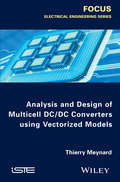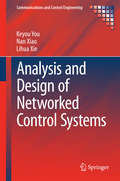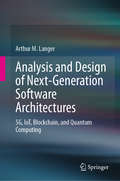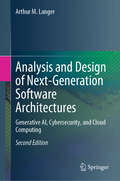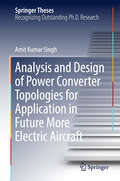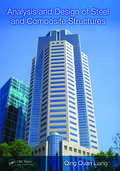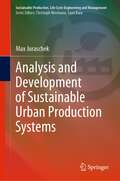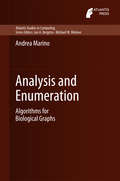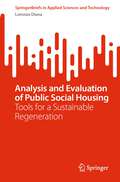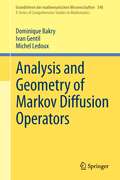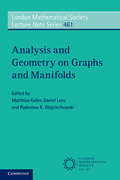- Table View
- List View
Analysis and Design of Multicell DCDC Converters Using Vectorized Models
by Thierry MeynardShows how the concepts of vectorization and design masks can be used to help the designer in comparing different designs and making the right choices. The book addresses series and parallel multicell conversion directly, and the concepts can be generalized to describe other topologies.
Analysis and Design of Networked Control Systems (Communications and Control Engineering)
by Keyou You Nan Xiao Lihua XieThis monograph focuses on characterizing the stability and performance consequences of inserting limited-capacity communication networks within a control loop. The text shows how integration of the ideas of control and estimation with those of communication and information theory can be used to provide important insights concerning several fundamental problems such as: · minimum data rate for stabilization of linear systems over noisy channels; · minimum network requirement for stabilization of linear systems over fading channels; and · stability of Kalman filtering with intermittent observations. A fundamental link is revealed between the topological entropy of linear dynamical systems and the capacities of communication channels. The design of a logarithmic quantizer for the stabilization of linear systems under various network environments is also extensively discussed and solutions to many problems of Kalman filtering with intermittent observations are demonstrated. Analysis and Design of Networked Control Systems will interest control theorists and engineers working with networked systems and may also be used as a resource for graduate students with backgrounds in applied mathematics, communications or control who are studying such systems.
Analysis and Design of Networked Control Systems under Attacks
by Fuchun Sun Yuan Yuan Hongjiu Yang Lei GuoThis book adopts a systematic view of the control systems in cyber-physical systems including the security control of the optimal control system, security control of the non-cooperative game system, quantify the impact of the Denial-of-Service attacks on the optimal control system, and the adaptive security control of the networked control systems. Because the cyber-physical system is a hybrid system, it adopts cross layer approach to handle the security control of the CPS. It presents a number of attack models according to the attack scenario and defense facilities, and a number of cross-layer co-design methodologies to secure the control of CPS.
Analysis and Design of Networks-on-Chip Under High Process Variation
by Rabab Ezz-Eldin Magdy Ali El-Moursy Hesham F. A. HamedThis book describes in detail the impact of process variations on Network-on-Chip (NoC) performance. The authors evaluate various NoC topologies under high process variation and explain the design of efficient NoCs, with advanced technologies. The discussion includes variation in logic and interconnect, in order to evaluate the delay and throughput variation with different NoC topologies. The authors describe an asynchronous router, as a robust design to mitigate the impact of process variation in NoCs and the performance of different routing algorithms is determined with/without process variation for various traffic patterns. Additionally, a novel Process variation Delay and Congestion aware Routing algorithm (PDCR) is described for asynchronous NoC design, which outperforms different adaptive routing algorithms in the average delay and saturation throughput for various traffic patterns.
Analysis and Design of Next-Generation Software Architectures: 5G, IoT, Blockchain, and Quantum Computing
by Arthur M. LangerThis book provides a detailed “how-to” guide, addressing aspects ranging from analysis and design to the implementation of applications, which need to be integrated within legacy applications and databases.The analysis and design of the next generation of software architectures must address the new requirements to accommodate the Internet of things (IoT), cybersecurity, blockchain networks, cloud, and quantum computer technologies. As 5G wireless increasingly establishes itself over the next few years, moving legacy applications into these new architectures will be critical for companies to compete in a consumer-driven and social media-based economy. Few organizations, however, understand the challenges and complexities of moving from a central database legacy architecture to a ledger and networked environment.The challenge is not limited to just designing new software applications. Indeed, the next generation needs to function more independently on various devices, and on more diverse and wireless-centric networks. Furthermore, databases must be broken down into linked list-based blockchain architectures, which will involve analytic decisions regarding which portions of data and metadata will be processed within the chain, and which ones will be dependent on cloud systems. Finally, the collection of all data throughout these vast networks will need to be aggregated and used for predictive analysis across a variety of competitive business applications in a secured environment. Certainly not an easy task for any analyst/designer!Many organizations will continue to use packaged products and open-source applications. These third-party products will need to be integrated into the new architecture paradigms and have seamless data aggregation capabilities, while maintaining the necessary cyber compliances. The book also clearly defines the roles and responsibilities of the stakeholders involved, including the IT departments, users, executive sponsors, and third-party vendors. The book’s structure also provides a step-by-step method to help ensure a higher rate of success in the context of re-engineering existing applications and databases, as well as selecting third-party products, conversion methods and cybercontrols. It was written for use by a broad audience, including IT developers, software engineers, application vendors, business line managers, and executives.
Analysis and Design of Next-Generation Software Architectures: Generative AI, Cybersecurity, and Cloud Computing
by Arthur M. LangerThe 2nd edition will add a major chapter on Generative AI in Software Architecture. This chapter will provide a comprehensive background in generative models, its impact on software design, evolution of new analysis methodologies, and the overall impact of the Systems Development Life Cycle (SDLC). The new edition will also have new sections relating to Generative AI in Cybersecurity analysis and design, including proactive threat detection, ethical issues regarding privacy, and generative AI workflows (Charlotte AI). Other updates include Legacy System interfaces with Generative AI, new impacts on project management, and Platform design architecture. The 2nd edition will have a number of editing changes and corrections, as well as about 30 pages net of some eliminations of outdated content.
Analysis and Design of Nonlinear Systems in the Frequency Domain (Springer Theses)
by Yunpeng ZhuThis book focuses on the development of three novel approaches to build up a framework for the frequency domain analysis and design of nonlinear systems. The concepts are derived from Volterra series representation of nonlinear systems which are described by nonlinear difference or differential equations. Occupying the middle ground between traditional linear approaches and more complex nonlinear system theories, the book will help readers to have a good start to analyse and exploit the nonlinearities. Analysis and Design of Nonlinear Systems in the Frequency Domain provides clear illustrations and examples at the beginning and the end of each chapter, respectively, making it of interest to both academics and practicing engineers.
Analysis and Design of Power Converter Topologies for Application in Future More Electric Aircraft (Springer Theses)
by Amit Kumar SinghThis thesis proposes new power converter topologies suitable for aircraft systems. It also proposes both AC-DC and DC-DC types of converters for different electrical loads to improve the performance these systems. To increase fuel efficiency and reduce environmental impacts, less efficient non-electrical aircraft systems are being replaced by electrical systems. However, more electrical systems requires more electrical power to be generated in the aircraft. The increased consumption of electrical power in both civil and military aircrafts has necessitated the use of more efficient electrical power conversion technologies. This book presents acomprehensive mathematical analysis and the design and digital simulation of the power converters. Subsequently it discusses the construction of the hardware prototypes of each converter and the experimental tests carried out to verify the benefits of the proposed solutions in comparison to the existing solutions.
Analysis and Design of Singular Markovian Jump Systems
by Guoliang Wang Qingling Zhang Xinggang YanThis monograph is an up-to-date presentation of the analysis and design of singular Markovian jump systems (SMJSs) in which the transition rate matrix of the underlying systems is generally uncertain, partially unknown and designed. The problems addressed include stability, stabilization, H∞ control and filtering, observer design, and adaptive control. applications of Markov process are investigated by using Lyapunov theory, linear matrix inequalities (LMIs), S-procedure and the stochastic Barbalat's Lemma, among other techniques. Features of the book include: · study of the stability problem for SMJSs with general transition rate matrices (TRMs); · stabilization for SMJSs by TRM design, noise control, proportional-derivative and partially mode-dependent control, in terms of LMIs with and without equation constraints; · mode-dependent and mode-independent H∞ control solutions with development of a type of disordered controller; · observer-based controllers of SMJSs in which both the designed observer and controller are either mode-dependent or mode-independent; · consideration of robust H∞ filtering in terms of uncertain TRM or filter parameters leading to a method for totally mode-independent filtering · development of LMI-based conditions for a class of adaptive state feedback controllers with almost-certainly-bounded estimated error and almost-certainly-asymptotically-stable corres ponding closed-loop system states · applications of Markov process on singular systems with norm bounded uncertainties and time-varying delays Analysis and Design of Singular Markovian Jump Systems contains valuable reference material for academic researchers wishing to explore the area. The contents are also suitable for a one-semester graduate course.
Analysis and Design of Steel and Composite Structures
by Qing Quan LiangSteel and composite steel–concrete structures are widely used in modern bridges, buildings, sport stadia, towers, and offshore structures. Analysis and Design of Steel and Composite Structures offers a comprehensive introduction to the analysis and design of both steel and composite structures. It describes the fundamental behavior of steel and composite members and structures, as well as the current design criteria and procedures given in Australian standards AS/NZS 1170, AS 4100, AS 2327.1, Eurocode 4, and AISC-LRFD specifications.Featuring numerous step-by-step examples that clearly illustrate the detailed analysis and design of steel and composite members and connections, this practical and easy-to-understand text: Covers plates, members, connections, beams, frames, slabs, columns, and beam-columns Considers bending, axial load, compression, tension, and design for strength and serviceability Incorporates the author’s latest research on composite members Analysis and Design of Steel and Composite Structures is an essential course textbook on steel and composite structures for undergraduate and graduate students of structural and civil engineering, and an indispensable resource for practising structural and civil engineers and academic researchers. It provides a sound understanding of the behavior of structural members and systems.
Analysis and Design of Steel and Composite Structures
by Qing Quan LiangSteel and composite steel–concrete structures are widely used in modern bridges, buildings, sport stadia, towers, and offshore structures. Analysis and Design of Steel and Composite Structures offers a comprehensive introduction to the analysis and design of both steel and composite structures. It describes the fundamental behavior of steel and composite members and structures, as well as the current design criteria and procedures given in Australian standards AS/NZS 1170, AS 4100, AS 2327.1, Eurocode 4, and AISC-LRFD specifications.Featuring numerous step-by-step examples that clearly illustrate the detailed analysis and design of steel and composite members and connections, this practical and easy-to-understand text: Covers plates, members, connections, beams, frames, slabs, columns, and beam-columns Considers bending, axial load, compression, tension, and design for strength and serviceability Incorporates the author’s latest research on composite members Analysis and Design of Steel and Composite Structures is an essential course textbook on steel and composite structures for undergraduate and graduate students of structural and civil engineering, and an indispensable resource for practising structural and civil engineers and academic researchers. It provides a sound understanding of the behavior of structural members and systems.
Analysis and Design of Transimpedance Amplifiers for Optical Receivers
by Eduard SäckingerAn up-to-date, comprehensive guide for advanced electrical engineering studentsand electrical engineers working in the IC and optical industries This book covers the major transimpedance amplifier (TIA) topologies and their circuit implementations for optical receivers. This includes the shunt-feedback TIA, common-base TIA, common-gate TIA, regulated-cascode TIA, distributed-amplifier TIA, nonresistive feedback TIA, current-mode TIA, burst-mode TIA, and analog-receiver TIA. The noise, transimpedance, and other performance parameters of these circuits are analyzed and optimized. Topics of interest include post amplifiers, differential vs. single-ended TIAs, DC input current control, and adaptive transimpedance. The book features real-world examples of TIA circuits for a variety of receivers (direct detection, coherent, burst-mode, etc.) implemented in a broad array of technologies (HBT, BiCMOS, CMOS, etc.). The book begins with an introduction to optical communication systems, signals, and standards. It then moves on to discussions of optical fiber and photodetectors. This discussion includes p-i-n photodetectors; avalanche photodetectors (APD); optically preamplified detectors; integrated detectors, including detectors for silicon photonics; and detectors for phase-modulated signals, including coherent detectors. This is followed by coverage of the optical receiver at the system level: the relationship between noise, sensitivity, optical signal-to-noise ratio (OSNR), and bit-error rate (BER) is explained; receiver impairments, such as intersymbol interference (ISI), are covered. In addition, the author presents TIA specifications and illustrates them with example values from recent product data sheets. The book also includes: Many numerical examples throughout that help make the material more concrete for readers Real-world product examples that show the performance of actual IC designs Chapter summaries that highlight the key points Problems and their solutions for readers who want to practice and deepen their understanding of the material Appendices that cover communication signals, eye diagrams, timing jitter, nonlinearity, adaptive equalizers, decision point control, forward error correction (FEC), and second-order low-pass transfer functions Analysis and Design of Transimpedance Amplifiers for Optical Receivers belongs on the reference shelves of every electrical engineer working in the IC and optical industries. It also can serve as a textbook for upper-level undergraduates and graduate students studying integrated circuit design and optical communication.
Analysis and Design of the Power-Split Device for Hybrid Systems
by Xiaohua Zeng Jixin WangThis book presents a comprehensive overview of power-split device (PSD) design. It discusses vehicle energy consumption characteristics, hybrid vehicle power request solutions, typical configurations, operating principle and simulation technology of PSD hybrid system, a multi-factor integrated parametric design method and a dynamic coordinated control method for PSD hybrid system. It also describes the finite element analysis, thermal analysis and optimization of the PSD based on a surrogate model, explains the theory behind the design and the simulation, and provides concrete examples. It is a valuable resource for researchers and the engineers to gain a better understanding of the PSD design process.
Analysis and Development of Sustainable Urban Production Systems (Sustainable Production, Life Cycle Engineering and Management)
by Max JuraschekManufacturing of products in urban production sites is connected to unique potentials, yet also to specific challenges. Urban factories can provide functional diversity and contribute positive impacts to a city. The concept of urban production receives rising attention in research and industry and it is recognized in its interdisciplinary nature. With a holistic approach from both the urban perspective and the factory perspective, negative impacts can be minimized, positive effects enabled and mutually beneficial, symbiotic combinations created. The presented framework and methods for the evaluation and implementation of sustainable urban production systems allow the assessment of impacts and provide the means to control and utilize the unique strengths of urban factories for cities and industry. This will allow a structured derivation of methods and measures from the concept of urban production for producing enterprises and the urban stakeholders.
Analysis and Enumeration: Algorithms for Biological Graphs (Atlantis Studies in Computing #6)
by Andrea MarinoIn this work we plan to revise the main techniques for enumeration algorithms and to show four examples of enumeration algorithms that can be applied to efficiently deal with some biological problems modelled by using biological networks: enumerating central and peripheral nodes of a network, enumerating stories, enumerating paths or cycles, and enumerating bubbles. Notice that the corresponding computational problems we define are of more general interest and our results hold in the case of arbitrary graphs. Enumerating all the most and less central vertices in a network according to their eccentricity is an example of an enumeration problem whose solutions are polynomial and can be listed in polynomial time, very often in linear or almost linear time in practice. Enumerating stories, i. e. all maximal directed acyclic subgraphs of a graph G whose sources and targets belong to a predefined subset of the vertices, is on the other hand an example of an enumeration problem with an exponential number of solutions, that can be solved by using a non trivial brute-force approach. Given a metabolic network, each individual story should explain how some interesting metabolites are derived from some others through a chain of reactions, by keeping all alternative pathways between sources and targets. Enumerating cycles or paths in an undirected graph, such as a protein-protein interaction undirected network, is an example of an enumeration problem in which all the solutions can be listed through an optimal algorithm, i. e. the time required to list all the solutions is dominated by the time to read the graph plus the time required to print all of them. By extending this result to directed graphs, it would be possible to deal more efficiently with feedback loops and signed paths analysis in signed or interaction directed graphs, such as gene regulatory networks. Finally, enumerating mouths or bubbles with a source s in a directed graph, that is enumerating all the two vertex-disjoint directed paths between the source s and all the possible targets, is an example of an enumeration problem in which all the solutions can be listed through a linear delay algorithm, meaning that the delay between any two consecutive solutions is linear, by turning the problem into a constrained cycle enumeration problem. Such patterns, in a de Bruijn graph representation of the reads obtained by sequencing, are related to polymorphisms in DNA- or RNA-seq data.
Analysis and Evaluation of Public Social Housing: Tools for a Sustainable Regeneration (SpringerBriefs in Applied Sciences and Technology)
by Lorenzo DianaThe book explores current characteristics of the urban built environment in view of possible future transformations. A cross-reading analysis of existing public social housing buildings is proposed, based on the investigation of their architectural, structural, and energetic characteristics. The study aims to provide an integrated approach that captures the link between typology, construction, and energy demands, offering a key to understanding the main critical issues and transformation readiness. It focuses on large-scale interventions composing public social housing stocks, realized during the second half of the twentieth century. More than other public interventions, such building stocks clearly lack in meeting current housing needs such as modern apartment architectural layout, energy and structural regulations, and social mix. However, due to their numerical presence, strategical and widespread distribution across urban areas, and transformability, these buildings can be the target for future strategic regeneration projects. In particular, the book thoroughly investigates the social housing estate constructed in Rome (Italy) after the approval in 1964 of the first urban economic and social housing plan.
Analysis and Geometry of Markov Diffusion Operators (Grundlehren der mathematischen Wissenschaften #348)
by Dominique Bakry Ivan Gentil Michel LedouxThe present volume is an extensive monograph on the analytic and geometric aspects of Markov diffusion operators. It focuses on the geometric curvature properties of the underlying structure in order to study convergence to equilibrium, spectral bounds, functional inequalities such as Poincaré, Sobolev or logarithmic Sobolev inequalities, and various bounds on solutions of evolution equations. At the same time, it covers a large class of evolution and partial differential equations. The book is intended to serve as an introduction to the subject and to be accessible for beginning and advanced scientists and non-specialists. Simultaneously, it covers a wide range of results and techniques from the early developments in the mid-eighties to the latest achievements. As such, students and researchers interested in the modern aspects of Markov diffusion operators and semigroups and their connections to analytic functional inequalities, probabilistic convergence to equilibrium and geometric curvature will find it especially useful. Selected chapters can also be used for advanced courses on the topic.
Analysis and Geometry on Graphs and Manifolds (London Mathematical Society Lecture Note Series #461)
by Daniel Lenz Matthias Keller Radoslaw K. WojciechowskiThe interplay of geometry, spectral theory and stochastics has a long and fruitful history, and is the driving force behind many developments in modern mathematics. Bringing together contributions from a 2017 conference at the University of Potsdam, this volume focuses on global effects of local properties. Exploring the similarities and differences between the discrete and the continuous settings is of great interest to both researchers and graduate students in geometric analysis. The range of survey articles presented in this volume give an expository overview of various topics, including curvature, the effects of geometry on the spectrum, geometric group theory, and spectral theory of Laplacian and Schrödinger operators. Also included are shorter articles focusing on specific techniques and problems, allowing the reader to get to the heart of several key topics.
Analysis and Geometry: MIMS-GGTM, Tunis, Tunisia, March 2014. In Honour of Mohammed Salah Baouendi (Springer Proceedings in Mathematics & Statistics #127)
by Ali Baklouti Aziz El Kacimi Sadok Kallel Nordine MirThis book includes selected papers presented at the MIMS (Mediterranean Institute for the Mathematical Sciences) - GGTM (Geometry and Topology Grouping for the Maghreb) conference, held in memory of Mohammed Salah Baouendi, a most renowned figure in the field of several complex variables, who passed away in 2011. All research articles were written by leading experts, some of whom are prize winners in the fields of complex geometry, algebraic geometry and analysis. The book offers a valuable resource for all researchers interested in recent developments in analysis and geometry.
Analysis and Identification of Time-Invariant Systems, Time-Varying Systems, and Multi-Delay Systems using Orthogonal Hybrid Functions: Theory and Algorithms with MATLAB® (Studies in Systems, Decision and Control #46)
by Anish Deb Srimanti Roychoudhury Gautam SarkarThis book introduces a newset of orthogonal hybrid functions (HF) which approximates time functions in apiecewise linear manner which is very suitable for practical applications. The book presents ananalysis of different systems namely, time-invariant system, time-varyingsystem, multi-delay systems---both homogeneous and non-homogeneous type- andthe solutions are obtained in the form of discrete samples. The book alsoinvestigates system identification problems for many of the above systems. Thebook is spread over 15 chapters and contains 180 black and white figures, 18colour figures, 85 tables and 56 illustrative examples. MATLAB codes for many suchexamples are included at the end of the book.
Analysis and Implementation of Isogeometric Boundary Elements for Electromagnetism (Springer Theses)
by Felix WolfThis book presents a comprehensive mathematical and computational approach for solving electromagnetic problems of practical relevance, such as electromagnetic scattering and the cavity problems. After an in-depth introduction to the mathematical foundations of isogeometric analysis, which discusses how to conduct higher-order simulations efficiently and without the introduction of geometrical errors, the book proves quasi-optimal approximation properties for all trace spaces of the de Rham sequence, and demonstrates inf-sup stability of the isogeometric discretisation of the electric field integral equation (EFIE). Theoretical properties and algorithms are described in detail. The algorithmic approach is, in turn, validated through a series of numerical experiments aimed at solving a set of electromagnetic scattering problems. In the last part of the book, the boundary element method is combined with a novel eigenvalue solver, a so-called contour integral method. An algorithm is presented, together with a set of successful numerical experiments, showing that the eigenvalue solver benefits from the high orders of convergence offered by the boundary element approach. Last, the resulting software, called BEMBEL (Boundary Element Method Based Engineering Library), is reviewed: the user interface is presented, while the underlying design considerations are explained in detail. Given its scope, this book bridges an important gap between numerical analysis and engineering design of electromagnetic devices.
Analysis and Integration of Behavioral Units (Psychology Library Editions: Cognitive Science #25)
by TRAVIS THOMPSON AND MICHAEL D. ZEILEROriginally published in 1986, this volume was the result of a conference in honor of the 65th birthday of the late Kenneth MacCorquodale, an exceptionally eloquent spokesman for the field of experimental analysis of behaviour at the time. The present volume grew directly out of the issues raised by MacCorquodale and Meehl in their "Excursis: The Response Concept" paper and which MacCorquodale posed so often when he taught. It is a fitting tribute to the man on his 65th birthday that a group of scholars whom he held in the highest regard convened in one place to think out loud about two of the thorniest problems facing behavioral science, namely, the nature of the units of analysis of the subject matter and the mechanisms responsible for their integration.
Analysis and Interpretation in the Exact Sciences: Essays in Honour of William Demopoulos (The Western Ontario Series in Philosophy of Science #78)
by Robert Disalle Melanie Frappier Derek BrownThe essays in this volume concern the points of intersection between analytic philosophy and the philosophy of the exact sciences. More precisely, it concern connections between knowledge in mathematics and the exact sciences, on the one hand, and the conceptual foundations of knowledge in general. Its guiding idea is that, in contemporary philosophy of science, there are profound problems of theoretical interpretation-- problems that transcend both the methodological concerns of general philosophy of science, and the technical concerns of philosophers of particular sciences. A fruitful approach to these problems combines the study of scientific detail with the kind of conceptual analysis that is characteristic of the modern analytic tradition. Such an approach is shared by these contributors: some primarily known as analytic philosophers, some as philosophers of science, but all deeply aware that the problems of analysis and interpretation link these fields together.
Analysis and Interpretation of Fire Scene Evidence
by José R. Almirall Kenneth G. FurtonOngoing advances in arson detection tools and techniques increase the importance of scientific evidence in related court proceedings. In order to assemble an airtight case, investigators and forensic scientists need a resource that assists them in properly conducting the chemical analysis and interpretation of physical evidence found at scenes of s
Analysis and Management of Productivity and Efficiency in Production Systems for Goods and Services
by Daniel Pacheco Lacerda Fabio Sartori Piran Luis Felipe CamargoIn companies that produce goods and services, productivity and efficiency improvements are a constant challenge. This book reviews the differences between productivity and efficiency. It proposes a new method and makes available a computational tool for implementation that contributes to facilitating the use of Data Envelopment Analysis (DEA). The book presents a discussion about productivity and efficiency, illustrating the potentials of use and conceptual differences. It covers the concepts and techniques for analysis of productivity and efficiency, analyzing critical benefits and limitations, explains in detail how to use DEA for analysis, provides innovative methods for using DEA, offers a free online computer tool with a direction guide, shows real empirical applications, and covers other techniques that can be used to complement the analysis performed. The book is for professionals, managers, consultants, students working and taking courses in productive systems of goods and services. Ancillary materials include a free online computer tool to operationalize the concepts and methods proposed in the book, a guide on how to use the method and the software developed for the DEA application. Solutions manual, instructor’s manual, PowerPoint slides, and figure slides also will be available upon qualified adoption.
